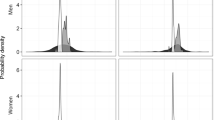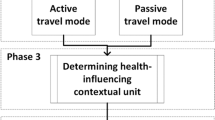Abstract
Typical resuspension activities within the home, such as walking, have been estimated to contribute up to 25% of personal exposures to PM10. Chamber studies have shown that for moderate walking intensities, flooring type can impact the rate at which particles are re-entrained into the air. For this study, the impact of residential flooring type on incremental average daily (24 h) time-averaged exposure was investigated. Distributions of incremental time-averaged daily exposures to fine and coarse PM while walking within the residential micro-environment were predicted using CONTAM, the multizone airflow and contaminant transport program of the National Institute of Standards and Technology. Knowledge of when and where a person was walking was determined by randomly selecting 490 daily diaries from the EPA’s consolidated human activity database (CHAD). On the basis of the results of this study, residential flooring type can significantly impact incremental time-averaged daily exposures to coarse and fine particles (α=0.05, P<0.05, N=490, Kruskal–Wallis test) with high-density cut pile carpeting resulting in the highest exposures. From this study, resuspension from walking within the residential micro-environment contributed 6–72% of time-averaged daily exposures to PM10.
This is a preview of subscription content, access via your institution
Access options
Subscribe to this journal
Receive 6 print issues and online access
$259.00 per year
only $43.17 per issue
Buy this article
- Purchase on Springer Link
- Instant access to full article PDF
Prices may be subject to local taxes which are calculated during checkout








Similar content being viewed by others
References
Yakovleva E, Hopke PK, Wallace L . Receptor modelling assessment of particle total exposure assessment methodology data. Environ Sci Technol 1999; 33: 3645–3652.
Qian J, Ferro AR . Resuspension of dust particles in a chamber and associated environmental factors. Aerosol Sci Technol 2008; 42: 566–578.
Englert N . Fine particles and human health—a review of epidemiological studies. Toxicol Lett 2004; 149: 235–242.
Pope CA . Epidemiology of fine particulate air pollution and human health: Biologic mechanisms and who's at risk? Environ Health Perspect 2000; 108 (Suppl 4): 713.
Brook RD, Rajagopalan S, Pope CA III, Brook JR, Bhatnagar A, Diez-Roux AV et al. Particulate matter air pollution and cardiovascular disease. Circulation 2010; 121: 2331–2378.
Klepeis NE, Nelson WC, Ott WR, Robinson JP, Tsang AM, Switzer P et al. The national human activity pattern survey (NHAPS): A resource for assessing exposure to environmental pollutants. J Expo Anal Environ Epidemiol 2001; 11: 231–252.
Tian Y, Sul K, Qian J, Mondal S, Ferro AR . A comparative study of walking‐induced dust resuspension using a consistent test mechanism. Indoor Air 2014; 24: 592–603.
Long CM, Suh HH, Koutrakis P . Characterization of indoor particle sources using continuous mass and size monitors. J Air Waste Manag Assoc 2000; 50: 1236.
Ferro AR, Kopperud RJ, Hildemann LM . Elevated personal exposure to particulate matter from human activities in a residence. J Expo Anal Environ Epidemiol 2004; 14: S34–S40.
Walton GN, Dols WS . (revision 2013-02-15). CONTAM User Guide and Program Documentation. NISTIR 2005. National Institute of Standards and Technology: Gaithersburg, 7251.
Wang L, Dols WS, Chen Q 2010 An Introduction to the CFD Capabilities in CONTAM 3.0. In SimBuild 2010 - Fourth International Conference of IBPSA-USA. New York City, NY: IBPSA.
Persily A, Musser A, Emmerich S . Modeled infiltration rate distributions for US housing. Indoor Air 2010; 20: 473–485.
Thatcher TL, Lai ACK, Moreno-Jackson R, Sextro RG, Nazaroff WW . Effects of room furnishings and air speed on particle deposition rates indoors. Atmos Environ 2002; 36: 1811–1819.
Qian J, Ferro AR, Fowler KR . Estimating the resuspension rate and residence time of indoor particles. J Air Waste Manage Assoc 2008; 58: 502–516.
Bramwell L . An Evalaution of the Impact of Flooring Types and Ventilation Conditions on Exposures to Fine and Coarse Particles within the Residential Micro-Environment Using CONTAM. Published doctoral dissertation, Clarkson University, Potsdam, New York. 2013.
Ainsworth BE, Haskell WL, Whitt MC, Irwin ML, Swartz AM, Strath SJ et al. Compendium of physical activities: An update of activity codes and MET intensities. Med Sci Sports Exerc 2000; 32 (9 Suppl): S498.
Tudor-Locke C, Sisson SB, Collova T, Lee SM, Swan PD . Pedometer-determined step count guidelines for classifying walking intensity in a young ostensibly healthy population. Can J Appl Physiol 2005; 30: 666–676.
McCurdy T, Glen G, Smith L, Lakkadi Y . The national exposure research laboratory's consolidated human activity database. J Expo Anal Environ Epidemiol 2000; 10 (6 Pt 1): 566–578.
Wallace L . Indoor particles: A review. J Air Waste Manag Assoc 1996; 46: 98–126.
Williams R, Suggs J, Zweidinger R, Evans G, Creason J, Kwok R et al. The 1998 Baltimore particulate matter epidemiology-exposure study: Part 1. Comparison of ambient, residential outdoor, indoor and apartment particulate matter monitoring. J Expo Anal Environ Epidemiol 2000; 10 (6 Pt 1): 518.
Williams R, Suggs J, Rea A, Leovic K, Vette A, Croghan C et al. The research triangle park particulate matter panel study: PM mass concentration relationships* 1. Atmos Environ 2003; 37: 5349–5363.
Chen Q, Hildemann LM . The effects of human activities on exposure to particulate matter and bioaerosols in residential homes. Environ Sci Technol 2009; 43: 4641–4646.
Thomas KW, Pellizzari ED, Clayton C, Whitaker DA, Shores RC, Spengler J et al. Particle total exposure assessment methodology (PTEAM) 1990 study: Method performance and data quality for personal, indoor, and outdoor monitoring. J Expo Anal Environ Epidemiol 1993; 3: 203.
Turpin BJ, Weisel CP, Morandi M, Colome S, Stock T, Eisenreich S et al. Relationships of indoor, outdoor, and personal air (RIOPA): Part II. Analyses of concentrations of particulate matter species. Res Rep Health Eff Inst 2007: (130 Pt 2): 1–77 discussion 79-92.
Williams R, Rea A, Vette A, Croghan C, Whitaker D, Stevens C et al. The design and field implementation of the Detroit exposure and aerosol research study. J Expo Sci Environ Epidemiol 2008; 19: 643–659.
Baxter LK, Clougherty JE, Paciorek CJ, Wright RJ, Levy JI . Predicting residential indoor concentrations of nitrogen dioxide, fine particulate matter, and elemental carbon using questionnaire and geographic information system based data. Atmos Environ 2007; 41: 6561–6571.
Nagda NL, Koontz MD, Konheim AG, Katharine Hammond S . Measurement of cabin air quality aboard commercial airliners. Atmospheric Environment Part A General Topics 1992; 26: 2203–2210.
Pierce WM, Janczewski JN, Roethlisberger B, Janczewski MG . Air quality on commercial aircraft. ASHRAE J 1999; 41: 26–34.
Lindgren T, Norbäck D . Cabin air quality: Indoor pollutants and climate during intercontinental flights with and without tobacco smoking. Indoor Air 2002; 12: 263–272.
Eatough DJ, Caka FM, Crawford J, Braithwaite S, Hansen LD, Lewis EA . Environmental tobacco smoke in commercial aircraft. Atmospheric Environment Part A General Topics 1992; 26: 2211–2218.
Adgate J, Weisel C, Wang Y, Rhoads G, Lioy P . Lead in house dust: Relationships between exposure metrics. Environ Res 1995; 70: 134–147.
Wang E, Rhoads GG, Wainman T, Lioy PJ . Effects of environmental and carpet variables on vacuum sampler collection efficiency. Applied Occupational & Environmental Hygiene 1995; 10: 111–119.
Zartarian V, Bahadori T, McKone T . Adoption of an official ISEA glossary. J Expo Anal Environ Epidemiol 2005; 15: 1–5.
Orendurff MS, Schoen JA, Bernatz GC, Segal AD, Klute GK . How humans walk: Bout duration, steps per bout, and rest duration. J Rehabil Res Dev 2008; 45: 1077–1089.
Rosati JA, Thornburg J, Rodes C . Resuspension of particulate matter from carpet due to human activity. Aerosol Sci Technol 2008; 42: 472–482.
ASTM Standard D5438, 2011, "Standard Practice for Collection of Floor Dust for Chemical Analysis," ASTM International, West Conshohocken, PA 2011, doi:10.1520/D5438-11www.astm.org.
Svendsen E, Thorne P, O'Shaughnessy P, Zimmerman D, Reynolds S . House dust collection efficiency of the high volume small surface sampler on worn carpets. J Occup Environ Hyg 2006; 3: 334–341.
Ashley K, Applegate G, Wise T, Fernback J, Goldcamp M . Evaluation of a standardized micro-vacuum sampling method for collection of surface dust. J Occup Environ Hyg 2007; 4: 215–223.
Acknowledgements
This research material is based upon work supported by the U.S. Department of Housing and Urban Development (HUD) under Grant Number NYLHH0168-08 and the U.S. National Science Foundation (NSF) under Grant Number CBET 0846704. The contents of this article are the views of the authors and do not necessarily reflect the views or policies of HUD, NSF or the U.S. Government. Special thanks are also expressed to Dr. Andrew Persily and members of the Energy and Environment Division, Indoor Air Quality and Ventilation Group, National Institute of Technology and Standards (NIST), Gaithersburg, MD.
Author information
Authors and Affiliations
Corresponding author
Ethics declarations
Competing interests
The authors declare no conflict of interest.
Additional information
Supplementary Information accompanies the paper on the Journal of Exposure Science and Environmental Epidemiology website
Supplementary information
Rights and permissions
About this article
Cite this article
Bramwell, L., Qian, J., Howard-Reed, C. et al. An evaluation of the impact of flooring types on exposures to fine and coarse particles within the residential micro-environment using CONTAM. J Expo Sci Environ Epidemiol 26, 86–94 (2016). https://doi.org/10.1038/jes.2015.31
Received:
Revised:
Accepted:
Published:
Issue Date:
DOI: https://doi.org/10.1038/jes.2015.31



